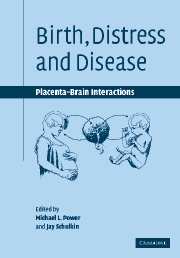Book contents
- Frontmatter
- Contents
- List of contributors
- Preface
- Introduction: brain and placenta, birth and behavior, health and disease
- 1 Placental expression of neurohormones and other neuroactive molecules in human pregnancy
- 2 The regulation of human parturition
- 3 Maternal nutrition and metabolic control of pregnancy
- 4 Fetal HPA activation, preterm birth and postnatal programming
- 5 Prenatal glucocorticoids and the programming of adult disease
- 6 Prenatal stress and stress physiology influences human fetal and infant development
- 7 Glucocorticoids and the ups and downs of neuropeptide gene expression
- 8 Glucocorticoid facilitation of corticotropin-releasing hormone in the placenta and the brain: functional impact on birth and behavior
- Index
Introduction: brain and placenta, birth and behavior, health and disease
Published online by Cambridge University Press: 16 October 2009
- Frontmatter
- Contents
- List of contributors
- Preface
- Introduction: brain and placenta, birth and behavior, health and disease
- 1 Placental expression of neurohormones and other neuroactive molecules in human pregnancy
- 2 The regulation of human parturition
- 3 Maternal nutrition and metabolic control of pregnancy
- 4 Fetal HPA activation, preterm birth and postnatal programming
- 5 Prenatal glucocorticoids and the programming of adult disease
- 6 Prenatal stress and stress physiology influences human fetal and infant development
- 7 Glucocorticoids and the ups and downs of neuropeptide gene expression
- 8 Glucocorticoid facilitation of corticotropin-releasing hormone in the placenta and the brain: functional impact on birth and behavior
- Index
Summary
This book focuses on the production and regulation of steroids, peptides, and other regulatory factors by the placenta and by maternal and fetal organs, especially brain. These regulatory factors play vital roles in the maintenance of pregnancy, the timing and onset of labor, fetal growth and development, especially the programming of fetal physiology, and maternal and fetal neural function and regulation. The maternal—placental—fetal axis is an important target for research into the regulation and control of human pregnancy. A subtext of the book is the role of maternal—placental—fetal interactions in the onset of disease and disability, especially from preterm birth and fetal programming of physiologic systems that lead to adult onset diseases, such as diabetes and hypertension. The book addresses the relationships among glucocorticoids, neuropeptides (primarily corticotropin-releasing hormone, CRH), maternal nutrition, psychosocial ‘stress’, fetal growth and development, the onset of labor, and subsequent effects on health and behavior of infants, children and adults (Figure I.1).
The placenta is not just a conduit of oxygen and nutrients from the mother to the fetus. It is not a passive organ, but rather it is very metabolically active. It metabolizes 40–60% of glucose and oxygen extracted from uterine circulation (Gluckman and Pinal, 2002, 2003).
- Type
- Chapter
- Information
- Birth, Distress and DiseasePlacental-Brain Interactions, pp. 1 - 15Publisher: Cambridge University PressPrint publication year: 2005



